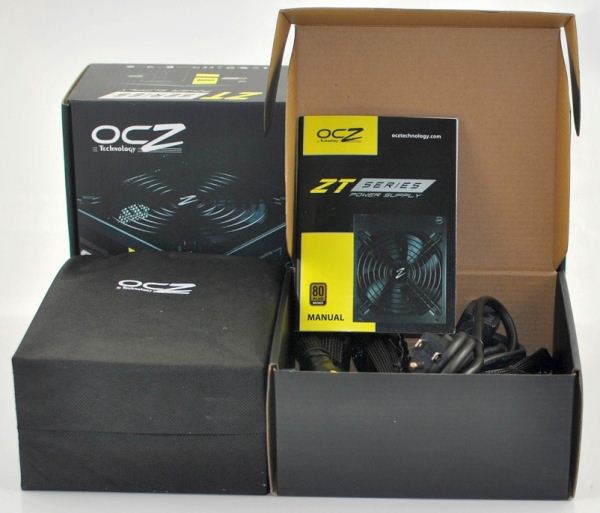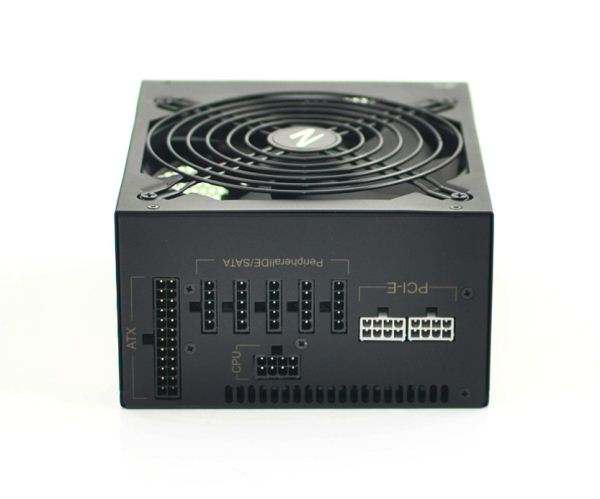Corsair TX vs. OCZ ZT 550W
by Martin Kaffei on March 26, 2012 9:30 AM EST- Posted in
- Cases/Cooling/PSUs
- Corsair
- PSUs
- OCZ
- 550W
- 80Plus Bronze
- ZT
- TX
OCZ ZT550W Overview
The OCZ ZT550W comes with the usual assortment of parts: you get an extensive user manual, a US/UK/Europe power cord (depending on your location), and the necessary mounting screws. In addition, the power supply has cable management, so some modular cables with a common sleeving are placed in the package as well.

Rated at up to 540W, the +12V rail can deliver nearly the full power of the PSU. +3.3V and +5V are rated at a maximum capacity of 24A each, with a combined output of 140W. Compared with most modern high-efficiency power supplies (like Corsair), OCZ has no DC-to-DC converters inside. In fact they use mag amp regulators for the smaller outputs which is a suitable solution too.
The whole housing is coated with a black finish. The fan grille with a OCZ logo in the middle is black too, and both sides of the case have an OCZ logo. As usual the ventilation holes are honeycombed and a large power switch is located next to the AC input. On the front are modular cable connectors, color coded for PCIe (grey) and peripherals (black). The depth of the device is 17,5cm, which is quite much for a 550W power supply.
| Cables and Connectors | ||
|
Connector type (length) |
Main | 1x 24-pin (55cm) modular |
| ATX12V/EPS12V | 1x 4+4-pin (60cm) modular | |
| PCIe |
1x 6/8-pin (55cm) modular 1x 6/8-pin (55cm) modular |
|
| Peripheral |
3x SATA (ca. 40, 55, 70cm) modular 3x SATA (ca. 40, 55, 70cm) modular |
|
|
3x Molex (ca. 40, 55, 70cm) modular 3x Molex (ca. 40, 55, 70cm) modular 1x FDD adapter (ca. 10cm) modular |
||
Again the 24-pin and CPU cables are relatively long with 55-60cm. Both 6/8-pin cables are 5cm shorter than the ones Corsair used. The cable sleeving somewhat better but they still use different colors for all wires and no flat cables. The FDD connector is a separate adapter that splits off a Molex connector if needed; there are six Molex connectors available. The peripheral cables have exactly the same lengths like the ones from Corsair, what a coincidence!



















41 Comments
View All Comments
A5 - Tuesday, March 27, 2012 - link
I wouldn't really call an SPL Meter app coupled with a bad tablet/phone microphone "objective". To get true, repeatable SPL numbers, you need to have a special test setup like SPCR.MeanBruce - Monday, March 26, 2012 - link
And the Corsair even looks better. Ok ok we all love Corsair PSUs, so is it now standard protocol for the company/groups on the bottom to offer new technology first and the group on top of the market to offer the same technology LAST? Am I the only enthusiast wondering where the Corsair Platinum PSU line-up is hiding? Is the strategy to wait and see what all other groups produce, then go to the drawing board simply to one-up the competition and stay on top of the market?johan851 - Monday, March 26, 2012 - link
One nice thing about not gluing down the fan connectors is that it's easy to replace that cheapo fan if/when it fails. :)jabber - Wednesday, March 28, 2012 - link
Yeah I finally got round to replacing the horrendous fan in my Corsair TX750 MK1.Sounded like a leaf blower after about 15 minutes of use. Dont quite know why it had to blow at 3000rpm all the while.
Swapped it out for a low start power 1700rpm fan and its been a lot better.
Rick83 - Monday, March 26, 2012 - link
I'm not really convinced that you can measure efficiency anywhere near a hundredth of a percent, accuracy wise, never mind that at that scale the slightest of atmospheric changes, input voltage changes, inter-series variation will void those results instantly.Especially using variations in those non-significant digits to mark advantages of one solution over another is a bit misleading. So unless you're absolutely convinced of those numbers, you should stick to values that you can reasonably expect to hold up under scrutiny.
Especially if your sample rates are 1, you should assume a certain variation, and ideally if over the course of testing you measure an average, also report the average std-dev.
Benchmarking is an engineering discipline!
ssj3gohan - Wednesday, March 28, 2012 - link
Wow, I never thought I'd meet somebody who I would agree with so much on this subject. Yes, measuring and properly representing your measurements is a key, key factor in benchmarking. Anandtech usually has their methods straight in other areas (although they consistently fail to include statistical parameters, really people, just because other sites don't show it doesn't mean you are allowed to omit them!) but power supplies are again (like I said in a lot of earlier PSU articles) their bastard child. Only results in table format, bad result representation in general, no methodology, no ambient conditions mentioned or tested against, very limited and unimaginative testing for that matter... it's like the exact opposite of, let's say, the SSD articles. As my go-to tech review site, this is extremely disappointing.Of course, I'm totally biased for being a PSU designer myself.
Chris Simmo - Monday, March 26, 2012 - link
I have been using GW PSU's for years (OE) and while they may not be quite as efficient as is stated here, they are incredibly reliable. We have used approximately 3000 PSU's in the PC building company we work for and had less than 20 fail over 4 years. The Corsair PSU's have been rubbish and we refuse to sell them. I have had customers bring us parts for assembly. Of 5 PSU's, 3 were DOA (TX750, TX850, AX850). I don't give a rats arse how efficient they are, they are not worth the money with this horrid a failure rate! Seasonic make awesome PSU's too, but they cost a pretty penny in comparison to the GW PSU's. Good on OCZ for picking a reliable company, not just for efficiencyBeenthere - Monday, March 26, 2012 - link
Both OCZ and Corsair have a sketchy history with PSUs in addition to other products. I would recommend buying a Seasonic or PC Power and Cooling PSU if people want performance and reliability.Holly - Tuesday, March 27, 2012 - link
Page 6, first sentence says "Corsair uses a 140mm fan from Yate Loon with a ball bearing." ... shouldn't it be "OCZ uses..." ?And as for Seasonic PSUs... I have had 6 of those in my hands last year in time span of 6 months. Out of those 3 had to be replaced due to heavy instability (one caused frequent BSODs, one caused system restarts and one air fan was extremely loud) immediately, two other gradually caused high system temperatures and the last one simply didn't start up after about 2 months usage. They were calculated so the system wouldn't load them over 60% at peaks.
It might be just a bad luck or Seasonic commits low quality products in my country, but I would never recommend or buy them again. I have had variety of Corsair PSUs in my hands from CX, TX, HX, VX and AX line, had to replace only one CX 500W because of excessive fan loudness.
Martin Kaffei - Tuesday, March 27, 2012 - link
You have good eyesight. Fixed and thanks.